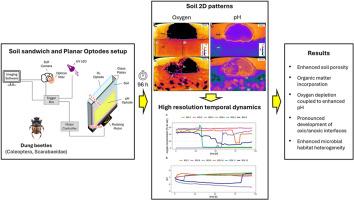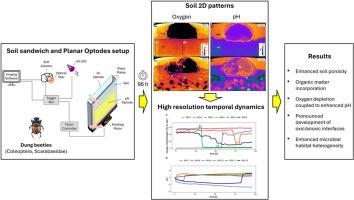平面光电图揭示了屎壳郎活动驱动下土壤氧和pH微环境的时空异质性
IF 10.3
1区 农林科学
Q1 SOIL SCIENCE
引用次数: 0
摘要
屎壳郎(鞘翅目,金龟甲科)通过粪埋和土壤混合对土壤生物地球化学循环做出了贡献,但在微观尺度上对土壤生物地球化学的影响知之甚少。我们利用平面光电成像技术同时解析了受隧道物种Onthophagus nuchicornis (Linnaeus, 1758)扰动的土壤中的氧和pH梯度。使用“土壤三明治”设置,我们在垂直平面上监测了96小时内土壤微环境的时空变化。甲虫产生了一个由隧道和粪球组成的异质网络,导致氧气和pH值梯度陡峭,二维氧-缺氧界面区增加了8倍。通过微传感器分析证实,掩埋的粪球表现出持续的缺氧,超过75%的体积在45小时内保持缺氧状态。缺氧导致pH值上升,超出缺氧区几毫米。使用荧光染料标记的纳米颗粒,我们还能够在淹水条件下跟踪粪便的运动,证明在缺氧条件下甲虫的活动尽管减少了,但仍在继续。对氧、pH和有机物再分配的综合影响增强了微生物栖息地的异质性,并有望促进好氧和厌氧过程(如硝化和反硝化)的耦合。最后,我们获得了土壤位移和粪便去除的定量估计,提供了蜣螂提供的生态系统服务的直接指标,包括增强土壤孔隙度和有机质埋葬。本文描述的新方法提供了对粪甲虫介导的土壤改良的微观过程的机制见解,维持了它们作为土壤生态系统工程师的作用。本文章由计算机程序翻译,如有差异,请以英文原文为准。


Planar optodes reveal spatiotemporal heterogeneity of oxic and pH microenvironments driven by dung beetle activity in soil
Dung beetles (Coleoptera, Scarabaeidae) contribute to soil biogeochemical cycling via dung burial and soil mixing, yet little is known about their impact on soil biogeochemistry at the microscale. We employed planar optode imaging to simultaneously resolve oxygen and pH gradients in soil bioturbated by the tunneling species Onthophagus nuchicornis (Linnaeus, 1758). Using a “soil sandwich” setup, we monitored spatial and temporal changes in the soil microenvironments across a vertical plane over 96 h. Beetles generated a heterogeneous network of tunnels and dung balls, leading to steep oxygen and pH gradients and an 8-fold increase in the 2D oxic-anoxic interface zones. Buried dung balls exhibited persistent anoxia, confirmed via microsensor profiling, with more than 75 % of the volume remaining anoxic for over 45 h. Oxygen depletion was coupled to a rise in pH extending millimeters beyond the anoxic zone. Using fluorescent dye-labeled nanoparticles we were also able to track dung movement under waterlogged conditions, demonstrating continued, albeit reduced, beetle activity under anoxia. The combined effects on oxygen, pH, and the organic matter redistribution enhance microbial habitat heterogeneity and are expected to favor the coupling between aerobic and anaerobic processes, such as nitrification and denitrification. Finally, we obtained quantitative estimates of soil displacement and dung removal, providing direct metrics of the ecosystem services delivered by dung beetles, including enhanced soil porosity and organic matter burial. The novel methodological approach described here provides mechanistic insights into the microscale processes underlying dung beetle-mediated soil modification, sustaining their role as soil ecosystem engineers.
求助全文
通过发布文献求助,成功后即可免费获取论文全文。
去求助
来源期刊

Soil Biology & Biochemistry
农林科学-土壤科学
CiteScore
16.90
自引率
9.30%
发文量
312
审稿时长
49 days
期刊介绍:
Soil Biology & Biochemistry publishes original research articles of international significance focusing on biological processes in soil and their applications to soil and environmental quality. Major topics include the ecology and biochemical processes of soil organisms, their effects on the environment, and interactions with plants. The journal also welcomes state-of-the-art reviews and discussions on contemporary research in soil biology and biochemistry.
 求助内容:
求助内容: 应助结果提醒方式:
应助结果提醒方式:


